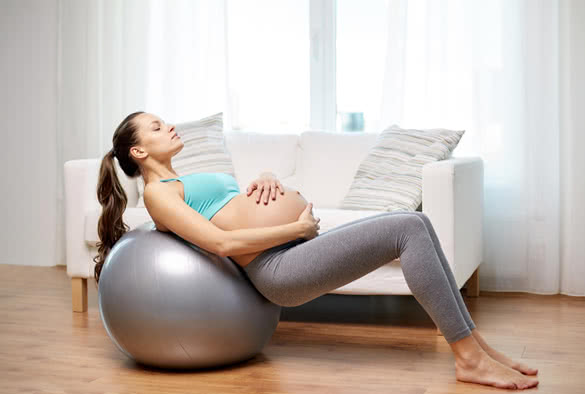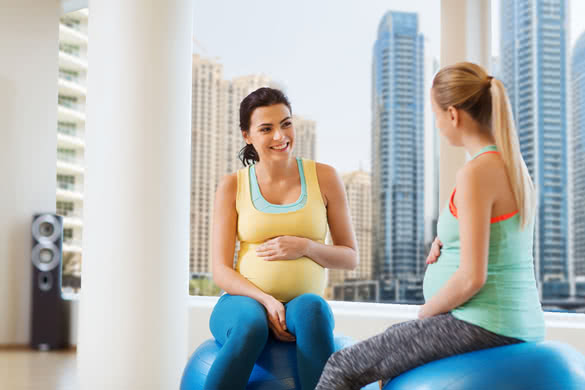When pregnant you don’t want to overdo your exercising so that you hurt yourself, or the baby, but you definitively want to exercise to build up strength for the birth and ensure your body stays happy and healthy throughout pregnancy.
So let’s have a look at why precisely you will want to exercise and what kind of exercising you should try! Please, keep in mind that this article is not designed to give medical advice. Always consult a healthcare provider before exercising when pregnant.
Why Exercise During Pregnancy?
According to Medical News Today the best type of exercise when pregnant:
▪ Increases your heart rate steadily and improves your heart circulation
▪ Keeps you flexible and limber
▪ Supports healthy weight gain and prevents excess weight gain by burning calories
▪ Prepares your muscles for labor and birth
▪ Will not cause you to push your body too hard.
And according to the same, pregnant women who exercise during their pregnancy may:
▪ Have a lower risk of gestational diabetes and hypertension
▪ Have less risk of preterm labor and birth
▪ Have a shorter labor process
▪ Be more likely to have a natural birth
▪ Be less likely to need pain relief
▪ Recover from childbirth faster
In addition to this Medical News Today also mentions that “research shows that when pregnant women exercise, their developing babies have a much lower heart rate.
Babies of active moms may also have a healthier birth weight, a lower fat mass, improved stress tolerance and advanced neurobehavioral maturation.” If that isn’t enough incentive to make you start exercising, what is?
Kegels
These famous exercises are all about training the muscles in your pelvic floor. If you haven’t heard of these exercises before, it’s basically doing exactly the same as you would when trying to stop yourself from peeing.
To figure it out, try stopping the flow of urine next time you use the bathroom. However, don’t do that more than as an exercise to find the muscles, as it’s not good for your to do it regularly. You want to practice when you don’t need to pee!
You need to exercise a few times a day, tensing and releasing the muscles about 15-30 times each time you practice. Also try tensing the muscles for a couple of seconds at a time during some sets. When exercising, make sure you aren’t tensing your abs at the same time.
Kegels will help you prevent incontinence before and after labor, as well as possibly decrease your active time in labor (after all, it helps to have strong muscles to push the baby into the world with).
Pelvic Exercises
It’s not just enough to exercise your pelvic floor – you need to exercise the whole pelvic area and the muscles that support it, such as your glutes (butt muscles).
According to Katy, Kegels aren’t that good for supporting you during pregnancy (though other studies suggest the opposite). What Katy says regarding working up strength in other muscles to support your pregnancy is indeed important though.
Katy suggests, first and foremost, squatting to build up your glutes. You have to do several squats a day, sticking your butt out as you do so, to build up the muscles properly. You can read more about her take on them here.
Another important exercise for your pelvic area, is to practice standing with your back against a wall and then pulling your pelvis and butt up and forward, so that your lower back flattens against the wall. Hold it for a while and then release.
Cardio
Cardio is very important for you to build up the strength you need to take you through labor. The best exercises for you and the baby are low impact ones that won’t upset your balance too much – with a baby on board your sense of balance sometimes gets affected.
Low impact aerobics (where you never lift more than one foot off the ground at the same time), walking, light jogging and swimming are some of the best ones. You can also do cycling, given it’s a stationary bike (i.e. there’s no chance of falling over and hurting yourself, or the baby!).
Swimming is great as it works on the whole body, whilst walking is easy to fit into your schedule and is an excellent form of cardio. Bear in mind when walking to choose smooth surfaces as the pregnancy progresses, as it’s easier to loose your balance.
You should never do anything where you exhaust yourself and you if you haven’t exercised previously, you need to slowly build it up.
Light Weight Training
Building up muscles to support the baby weight can help prevent injuries during pregnancy. However, it’s important you work with someone qualified who can tell you what weight training is best for your body during pregnancy.
Pre-Natal Yoga
Yoga classes for expecting moms is a perfect place to meet other moms to be, as well as get some exercising done. There are even some studies suggesting women who do yoga have easier births!
Not least because they learn breathing and meditation, which can help them keep calm and grounded during delivery. As you enter your second trimester, avoid positions where you lie flat on the back, as it puts too much pressure on certain veins and arteries.
Also bear in mind that your center of gravity will shift, so avoid poses that require too much balancing, so as to prevent falling over. Due to pregnancy your body will release hormones that increase mobility and joint flexibility, so beware not to overstretch.
Notes on Safety
As mentioned, it’s important not to overdo the exercising – you should never push yourself to the point of exertion. Likewise, you should avoid over stretching, but it is important to stretch before and after you exercise.
Always keep in mind that your center of gravity shifts as the pregnancy progresses and you will want to avoid exercises that might have you toppling over. Also, be sure to exercise on flat ground so as to lessen the risk of falling, which might injure you or the baby.
If you suffer from a low placenta, vaginal bleeding/spotting, high risk of miscarriage or premature birth or a weak cervix, you need to discuss your exercise plans with a doctor before you start any form of exercising, so as to ensure you stay safe.
When doing classes, try to stick with classes for pregnant mothers, so as to ensure all movements are safe (also check that the instructor is certified) and when doing weight training, work with a personal trainer who is trained in understanding weightlifting for pregnant women.
Last, but not least, having a midwife and/or doula, whom you speak with throughout pregnancy is a great idea as they can recommend specific exercises that may help support your pregnancy and prepare you for labor.
Exercising when pregnant can help you protect your body from unnecessary strain, prepare you for labor and ensure you don’t gain unnecessary weight. You just have to ensure that you do exercising that’s safe for you and the baby and that you don’t overdo neither the training, nor the stretching.















Add Comment